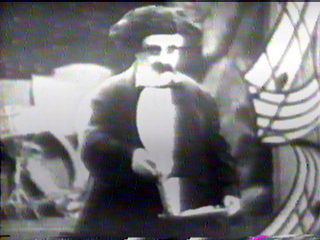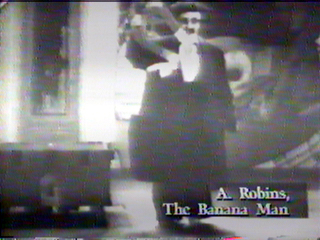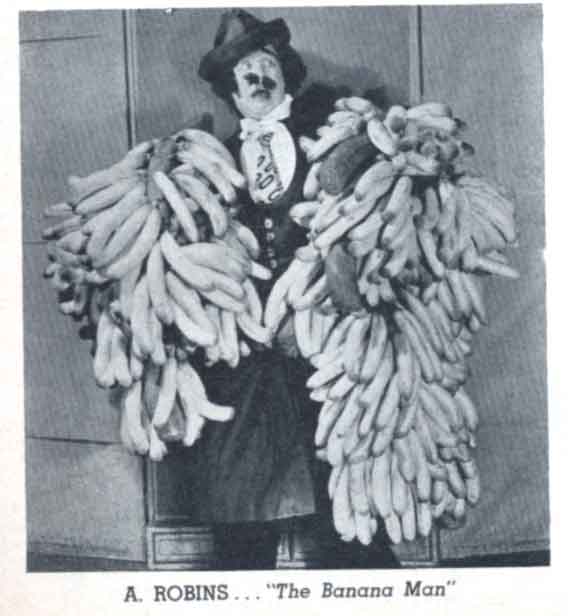
History

(An early image of A. Robins - from "Seeing Red", 1939)


(An early image of A. Robins - from "Seeing Red", 1939)
Anyone attempting to name the most unusual variety act of all time would HAVE to consider the act of Mr. A. Robins. His Banana Man act has fascinated almost everyone who ever saw it over the years. He was born in as Adolphe Proper in Vienna, Austria around 1886.
His father was a cabinet maker and did not approve of young Adolphe's path into show business. At the point he found he would be working regularly as a clown with his "walking music store" act, he changed his name to A. Robins (apparently in a tribute to his favorite painter, Peter Paul Rubens.
This web site is presented as a homage to the man and the act. It attempts to gather in one place all that can be learned about The Banana Man act.
A. Robins was a vaudeville performer who likely was from Europe. There is a very small portion of his act on the PBS special American Masters Production of Vaudeville, 1997. The segment shows A. Robins in his baggy suit producing a tray, glass, bottle with liquid, music stand, page of music (on the rear of his shirt front) and the mandolin that appears in later videos. He is identified as A. Robins The Banana Man.
After posting this web site about The Banana Man, I have received numerous communications from people who have seen the material - many who have offered additional information. The most intriguing message came from Frank Cullen who founded the American Vaudeville Museum. He tells me that the issue of the journal published quarterly by that museum (the issue of Jan 01, 2002) has an article titled "The Mystery of A. Robins." They believe Robins stopped performing the act around the beginning of World War II.
The brochure that I have was sent to me by Max Roth in the late 1960's. It is clearly labeled A. Robins, The Banana Man. Max Roth is listed on page three as the agent (along with Bernard Burke.) Although I had heard the act had been sold and/or franchised to others, this information that all of the performances of the Banana Man were by someone OTHER than A. Robins. What is not in dispute is the fact that there was a vaudeville performer named A. Robins who performed an act billed as "The Walking Music Store." He did appear in two films, "Seeing Red" in 1939 and "Mother Wore Tights" in 1947. Although he did not produce any bananas in the Seeing Red film, there are bananas produced (among with other fruit as well) in the Mother Wore Tights film. This may be the first instance on film showing the Banana Man actually producing bananas. It is still not clear exactly who the performer is in this film.
Since “publishing” this series of pages as a tribute to the character and performances of The Banana Man, I have had contact with people who have been able to provide me first hand information on the successor to A. Robins. The reliability of the sources and depth of the information leave no doubt in my mind about who did take over the act in the 1950’s and who was the performer playing the character most remembered by generations of TV viewers who saw one of the many permutations of the act. This new information is detailed on the page devoted to Sam Levine as The Banana Man.
The fact remains that there WAS a performer who appeared as The Banana Man and that performance is remembered by many with some affection. Even if Max Roth always was The Banana Man, he continued to use the A. Robins name in association with the performances. This site shall continue to document information about the permutations of the A. Robins name and the Banana Man character.

Snatches of information about the Banana Man have been uncovered over the years. Much is hearsay and speculation. I have heard that when A. Robins "retired" the act he sold it to someone who performed it for a time just as he had been taught by A. Robins.
One correspondent has told a story related to the television recording of the act. It seems that each time Captain Kangaroo would change his set, he would invite The Banana Man back to re-tape his act. Since the voluminous costume was impossible to dry clean, it is suggested that no one wanted to be in the studio when the act was being recorded because of the powerful smell.
John Moehring remembers being taken to a supermarket by his Aunt Polly to see the act performed in the parking lot! This would have been in Houston, TX around 1949. John remembers the train getting longer and the costume changes more than the "magical" productions of produce. He also remembers it was the first time he was aware of how annoyning a kazoo could be. He was later to learn that the sound was likely produced by means of a "swazzle" (as used by Punch & Judy operators.) John has been told that Robins "franchised" the Banana Man character to clowns in the United States. John also has seen a video of Robins' act on the "It's Magic" show that aired on CBS in 1955. On that show he was introduced as "A. Robins, Magical Clown."
Jim Steinmeyer (whose source was Jay Marshall) tells me A. Robins was a New York theatrical prop maker, specializing in small props for the stage. He was well known for the immaculate state of his shop. His standard "trick" for visitors was to be blindfolded in his shop. Someone would request an item, like a "One inch, 1/4-20 bolt," and he would walk directly to the drawer, open it and remove the bolt. Clearly Robins made everything in his act. All of the things produced (bananas, watermelons, pineapples, violin, etc) were cloth covered "spring items."
Jim recalls he may have seen a part of the act in "Meet Me In St. Louis" (or Easter Parade - one of those MGM period musicals.) He believes that Robins sold the act to another fellow who performed it for a time. Jay Marshall remembered him as "Larry of the Radio Aces" (a singing group).
Chet Dowling (who served as an usher in vaudeville many years ago), remembers seeing A. Robins perform an act called "A One Man Music Store." It is certainly easy to see how he could fill one spot on the bill doing his voice imitations of all of the instruments that he produced.
The Banana Man appeared as a vaudeville performer in "Mother Wore Tights" (1947) (In an uncredited performance), staring Betty Grable. IF the performer were to be A. Robins - he would have been 61 years old and the person in the film is CLEARLY much younger. The Levine family tells me that it is not their father in the film. So, this part of the story remains a mystery. He does, however, produce bananas in his brief film appearance. As a sort of “finale”, he produces a large stalk of REAL bananas - something he was never again seen doing.
In the summer of 1943, the Ringling Brothers presented "Spangles, The Continental Circus." The original A. Robins, close to the end of his career as The Banana Man appeared as "Display No. 9" - closing the first act of the show. His billing read: "The Banana Man Himself! Pre-eminent Star of Continental Circus and Music Hall fame - The Inimitable A. Robins The Walking Victory Garden, Artfully Assisted by Seductive Spangelettes." The addition of the Spangelettes was pretty strange to an act that was used to being a single.
The program for this 1943 show contains a publicity photograph and a short feature article:
A. ROBINS..."The Banana Man"
* No one has yet discovered exactly the tight word to describe A. Robins. He has been termed a clown, a wizard, musician, impersonator and jack-of-all-trades.
* Robins comes back from a tour of Europe. His native city, Vienna gave to the stage such other jesters as Toto, and Joe Jackson of bicycling repute. His father was a merchant and wanted him to be a respectable business man.
* Robins, whose real name is Adolph Proper, would rather draw and paint, and he was more interested in magic and acrobatic tricks: After starting out in life as an illustrator, he eloped with a circus as a lightning-sketch artist. He doubled-in-brass, too, as a clown and magician.
*The palette and brush was forgotten when he
learned the theatrical possibilities of his talent for quick-change
costumes and imitating musical instruments. He makes his own
ingenious costumes, wigs, collapsible instruments
and odd stage "props" himself.
* Robin still dabbles with paints as a hobby. For exactly 27 years he has been trouping behind footlights, resting only six weeks each year, but during his "vacations" he is busier than ever working in his New York workshop.
The original Banana Man, A. Robins died December 17, 1950. He had been on the Queen Elizabeth ocean liner when he was taken ill. He died in Bournemouth, England.
Bill Mullins has shared with me some reviews and notices associated with the original Banana Man's early performances in the US. The reference to the show "Katinka" was taken from the Internet Broadway database. The rest of the references were from various newspaper notices. In them you will find what likely is the first mention of Robins using bananas in his act and a reference to a banjo playing character. The banjo man character was found in the original props trunks but we had no idea where it appeared in his act. Here are the reviews and notices:
There is a four page article on the history and lore of the Banana Man in the August 2002 issue of MAGIC Magazine. It was written by Rhett Bryson and has numerous photographs.
Anyone having additional information about A. Robins' life, his act or any related information (including additional pictures) is encouraged to contact Rhett Bryson so that the new information can be added to this site.
|
|
|
|
|
|
|
|
|
|
|
|
|
|
|
|
|
|
©2001 Rhett Bryson
If you have ANY Banana Man stories, material or information,
Please eMail Rhett
Bryson (rhett.bryson@furman.edu)
Last Updated 05/20/2002